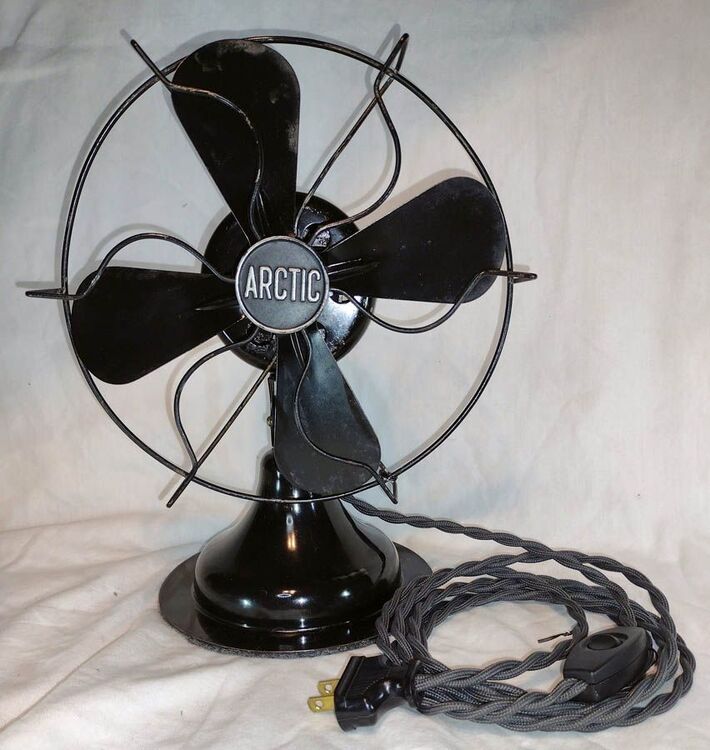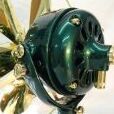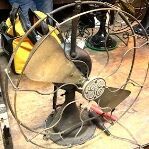Leaderboard
Popular Content
Showing content with the highest reputation on 10/20/2022 in all areas
-
..OK.. sadly not free to you, but it was to me.. So am I bragging or complaining? Well again sadly I’m bragging.. but there is good news.. FYI ...after a high polishing job the blade got out of balance so I made a custom arbor for my Du-bro prop balancer, then fire up the wife’s nasty hotmelt gun..So It was much easier than standard ones.. The best part you can add or take weight as needed from the inside of the dome.. just squirt hotmelt opposite the heavy side, until there is no heavy side...4 points
-
Sometimes a fan isn't expensive, rare, or sought-after, but it fits a particular task very well. For me, the inexpensive Arctic fan pictured below fits that description. I imagine it was originally sold at a dime-store like Woolworth's for $3.95 - $4.95. I bought this single speed non-oscillating fan locally for $15 about three years ago. I was looking for a small fan to gently move cigar smoke away when working on the computer. It performs that task very well, while also providing light air circulation when the weather dictates. Even better, this little fan isn't quite powerful enough to blow papers around the desk. It's a perfect match for the job at hand. I guess little fans like this were the original 'personal' electric fans. [QUESTIONS] 1. I'm assuming the (plastic or Bakelite) 'Arctic' badge means it's an 'Arctic Aire'. Is that correct, or was there more than one mfr. using the Arctic name? 2. Has anyone cleaned a felt oil ring with acetone? Will that destroy the felt? 3. I'm curious as to when it was mfr'd. -- My Interweb searches have failed to turn up a single picture of a similar Arctic fan. However, image searches did turn up a few pictures and images of late 1920's & early 1930's Polar Cubs with the flat bottom ring. (Here's an image of a Polar Cub with a similar silhouette in an ad posted in the old AFCAFORUM by Bill Hoehn.) However, THIS POST in the old AFCAFORUM provides a link to an article that states Polar Cubs were mfr'd by A.C. Gilbert while Arctic Aire fans were mfr'd by F.A. Smith - so it's not a case of the same mfr. but different brands. Maybe this line of Arctic fans were mfr'd as competition for the Polar Cubs in the early 1930's? Until I saw images of those early Polar Cubs my best uneducated guess was this fan dated to the late 40's. Now I don't even have a guess. Can anyone provide an approximate mfr. date for this fan? Even an approximate decade would be welcome. Thanks for reading the questions and for any insights you can provide! [Pictures] Unfortunately, all of my 'before' pics were lost in a hard drive crash. [Background & Repair] The seller said he bought the fan intending to fix it up but just never found the time. The fan apparently did not come with a switch, unless one was provided on the original wall cord. As received, it had no cord at all. The cage was out of shape and a previous owner bent two of the blades through the back of the cage, and then at a 90 degree angle, flush with the top of the motor. (Fan abuse!) The body and motor housing are thin pressed steel - and the blades are even thinner pressed steel, which were easily straightened while (surprisingly) leaving no clue as to their previous contortions. As the blades were so severely bent, I fully expected them to break or at least retain an obvious crease, but I guess that's one of the advantages of cheap metal. The blades were then aligned by eye, and a quick strobe check showed no additional alignment was necessary. The cage wire was easy to manipulate and bend back into shape. After a thorough cleaning, some small paint repairs with black nail polish, very fine sandpaper for paint blending, and then an application of Turtle Wax - it looks presentable. And after adding some shims to the rotor, cleaning and saturating the felt oil rings & the felt surrounded bearing carriers, and adding a power cord, it runs fine too. (Was amazed at how much oil those felt pieces could hold.) There's no indication this fan came from the factory with anything resembling feet or felt but I added some felt to the bottom to prevent the fan from very slowly rotating when sitting on a slick surface. Sometimes I think the little guy needs new paint. But a new paint job would erase a history recorded in wear and battle scars... I'll probably paint it sometime in the future anyway. In my web searches I saw some minimal and tasteful pin-striping on a freshly painted Polar Cub that I may try to emulate. [Nuisances] 1. The biggest nuisance for this fan is that it has to be completely disassembled to add oil to the felt oil rings and felt-surrounded bearings. There are two metal rods, threaded at either end, that hold everything together. (front and back motor housings, stator, bearings, shims, oil rings, cage) The internal nuts on the threaded rods have to be in the exact proper location for everything to fit properly, while you're simultaneously trying to hold everything together. The simple task of adding oil to the fan really tries my patience. Due to this Rube_Goldberg-esque design (obscure-reference alert) I doubt it was oiled more than a scarce few times over the years. Yet it still runs like it was built yesterday. Maybe this design was common; I don't know. -- On the bright side, the thick felt retains enough oil such that the fan only needs to be opened up once per year no matter how many hours it's run. Even then the oil just needs topping up. Anyway, it probably ran with no oil at all for most of its life. 2. One other minor nuisance is that when the motor warms up it puts out an unpleasant odor. I usually don't mind a light, old-fan machine-shop odor. Reminds me of shop class. But this particular odor is nasty machine shop meets stinky feet, and it gets old pretty quick if there isn't a cigar on fire to cover it. To remove the odor, a few weeks back I finally took it apart, cleaned/varnished the stator and wrapped the coils with friction tape. After many hours of runtime that funky odor was mostly still there. The felt oil reservoirs are the only places left where the stink can be hiding. When the fan was first taken apart all of the felt was soaked overnight in mineral spirits and thoroughly cleaned to remove the old thickened oil. Looks like I need to repeat the process the next time the fan is apart, maybe using acetone instead. (Hopefully, acetone won't destroy the felt.) An unexpected benefit of cleaning/varnishing the stator was the running temperature was significantly reduced. Prior to cleaning and varnishing the stator, the motor housing just passed the threshold of being uncomfortably warm to the touch. Now it feels barely warm. Unfortunately, I did not take 'before' temp. readings as I didn't anticipate this. [CURRENT MEASUREMENTS] - .43 amps, 41 watts - Temp: 95-100° F (Ambient Temp 70° F) (depending on where the IR thermometer gun is pointed) [Unexpected Coil Issue] When cleaning the windings I found a single stray loop of coil wire I hadn't noticed before. (Time for a eye exam.) It stood away from the rest, and was about one inch longer than the other coil wires. It also had a sharp kink in it. I first assumed this wire must be one of the leads, but both ends of the loop disappear into the middle of the coil, away from the leads. Also, both leads have the same length of exposed wire for attaching the wall cord. After some trial poking and prodding I quickly realized there was no way to remove the kink without the likely result of breaking that wire. Also, the wire had some shiny silver sections indicating wear, possibly due to flopping against the rotor. So what to do with it? The kink was left alone and that wire was left separated and apart from the others. -- The other wires were wrapped as normal, the stray wire was then folded over top of the friction tape and a second layer of tape sandwiched the stray wire. That stray wire seems very abnormal but since this was an inexpensive fan to begin with, perhaps everything tested good - so the foreman gave it the good-enough thumbs up at the factory. (As opposed to the just-push-it-out-the-factory-door middle finger.)1 point
-
My girlfriend wanted to restore a fan on her own. It'll be a Christmas gift for her dad who has a huge collection of Detroit Lions stuff. She disassembled it, drilled out the bearing retainers, blued all of the hardware, sandblasted everything and did the bodywork. Then she stripped and rewound the stator. I sprayed the epoxy primer and she did all of the wet sanding and got it ready for paint. I sprayed the base/clear urethane and did the final wet sanding and buffing. Here's some before and after pics.1 point
-
Happy early Christmas and glad you made it through your ordeal this year! Send me your address, I got a present for you. I like to send early instead of Christmas time.1 point
-
Just something Ge tried after wwI , the 2 stars had a speed coil as did the bell oscillators . Somewhere in that transition they tried a no speed coil unit. The speeds are wound in the stator.1 point


















